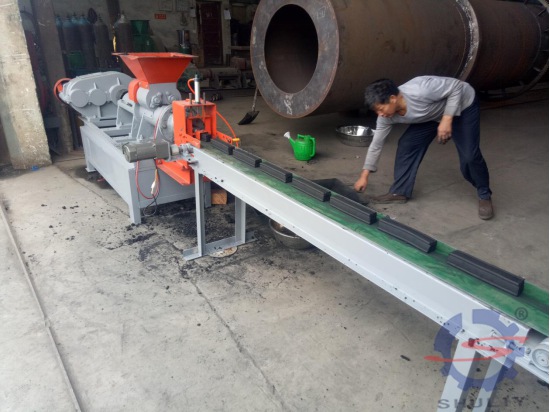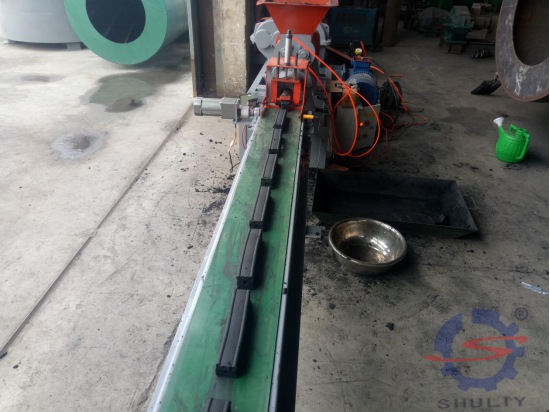Mesin yang terbuat dari arang harus diproduksi menggunakan mesin profesional yang terbuat dari peralatan mesin arang, dan bahan baku dari produk arang mesin tidak dapat terbuat dari sembarang bahan baku. Baru-baru ini, banyak pelanggan proyek peralatan mesin arang yang berkonsultasi menanyakan apakah mungkin menggunakan jerami tanaman sebagai bahan mesin.
Di sini, Pabrik Manufaktur Mesin Shuliy sangat bertanggung jawab untuk memberitahukan kepada sebagian besar teman bahwa jerami tidak dapat digunakan hanya untuk produksi arang. Mesin yang terbuat dari arang harus didasarkan pada bahan baku kayu. Bahan baku lain yang dapat digunakan adalah cangkang kacang tanah, tongkol jagung, serbuk gergaji, serbuk gergaji, dll., yang memiliki aplikasi yang luas dan dapat memenuhi berbagai kebutuhan produksi, sehingga peralatan mesin arang lebih banyak digunakan.

Mesin arang bekerja
Peralatan mesin arang menggunakan serbuk gergaji sebagai bahan baku untuk produksi karbon. Serbuk gergaji banyak digunakan. Serbuk gergaji diproduksi dan dimanfaatkan di berbagai daerah. Serbuk gergaji digunakan sebagai bahan baku untuk pemrosesan dan produksi. Ini juga merupakan salah satu metode produksi dari proses perbandingan. Peralatan mesin arang perlu memperhatikan serangkaian masalah saat menggunakan serbuk gergaji sebagai bahan baku untuk produksi karbon agar peralatan mesin arang dapat diproduksi dengan lebih baik.
Saat menggunakan serbuk gergaji sebagai bahan baku, peralatan mesin arang perlu menguasai suhu serbuk gergaji dan ukuran partikel serbuk gergaji. Kualitas bahan baku berhubungan langsung dengan arang jadi, dan ukuran partikel serbuk gergaji sebaiknya antara 3-6mm. Kualitas arang yang dihasilkan juga yang terbaik.
Pada saat yang sama, arang jadi yang dihasilkan oleh peralatan mesin arang mudah terbakar, dan arang jadi harus ditempatkan dengan aman untuk menghindari kebakaran. Penggunaan bahan baku yang luas membuat perlu untuk menerapkan metode dalam proses produksi karbon untuk menghasilkan arang buatan mesin yang sesuai untuk menciptakan lebih banyak manfaat ekonomi.
Dalam industri daur ulang tanaman tradisional, tingkat pemanfaatan jerami tanaman di China sekitar 33%, dan tingkat pemanfaatan teknologi pengolahan hanya sekitar 23%, sebagian besar tidak diproses, dan tingkat pemanfaatannya sangat rendah. Pemborosan sumber daya sangat besar. Sebagai negara pertanian tradisional, bagaimana cara memanfaatkan sumber daya jerami tanaman secara komprehensif memiliki signifikansi pengembangan yang penting untuk menghemat sumber daya, melindungi lingkungan, dan mempromosikan pembangunan pertanian yang berkelanjutan, dll. Ini juga memiliki prospek pengembangan yang luas.
Ada banyak cara utama untuk menggunakan kembali jerami pertanian, batang jagung, dll., yang dapat digunakan sebagai energi, pakan, limbah, bahan baku untuk produksi, dll., dan dapat digunakan untuk pemanasan, produksi biogas, karbonisasi, pembangkit listrik, dll. Munculnya mesin arang telah memungkinkan penggunaan jerami, batang jagung, dan tanaman lainnya mencapai tingkat baru. Jerami dan tanaman lainnya dapat digunakan untuk membuat arang jerami untuk mencapai pemanfaatan terbaik dan pemanfaatan maksimum.

Pada saat yang sama, tekanan tertentu diterapkan untuk memadatkan bahan baku jerami campuran. Setelah proses pencetakan selesai, arang jerami berbentuk batang terbaru diperoleh, yang merupakan proses produksi sederhana dari pengkarbonan jerami.
Pada tahap pengembangan saat ini, penerapan teknologi karbonisasi jerami untuk tanaman jerami adalah jenis transformasi baru dari ekonomi ekstensif ke ekonomi yang lebih efisien. Karbonisasi jerami yang ditinggalkan dan tanaman lainnya tidak hanya meningkatkan pemanfaatan sumber daya secara komprehensif tetapi juga menghilangkan bahaya dan polusi yang ditimbulkan oleh pembakaran jerami serta meningkatkan pendapatan ekonomi petani, dapat dikatakan sebagai solusi terbaik untuk pengembangan siklus komprehensif.
